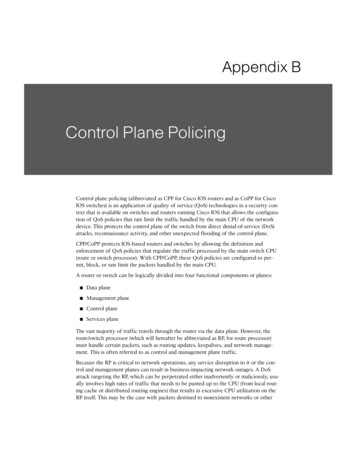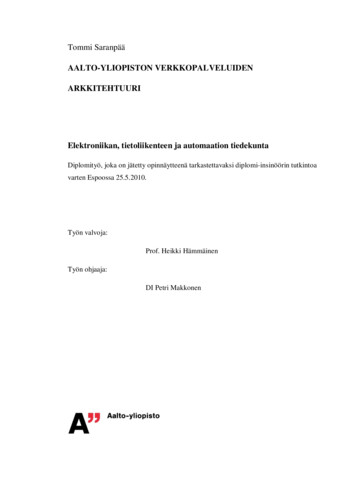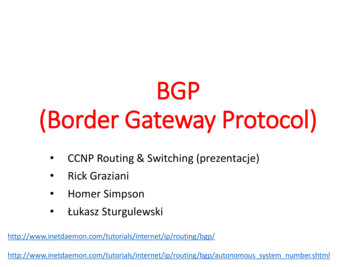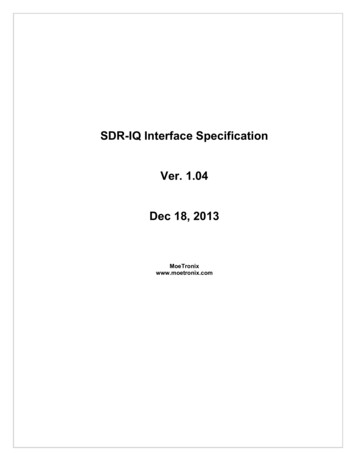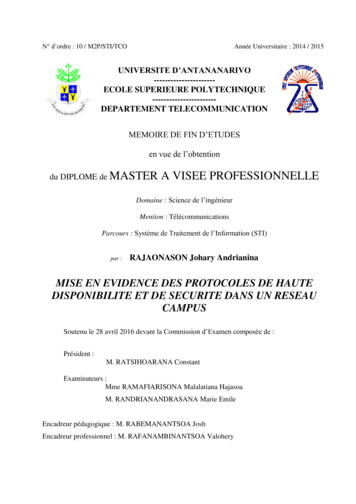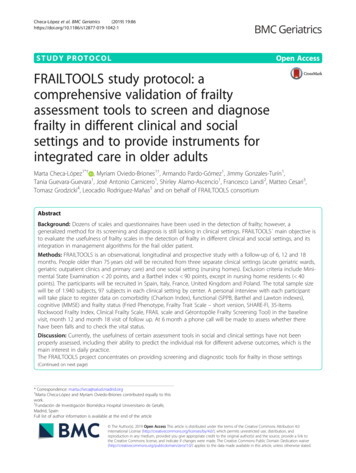
Transcription
Checa-López et al. BMC Geriatrics(2019) Y PROTOCOLOpen AccessFRAILTOOLS study protocol: acomprehensive validation of frailtyassessment tools to screen and diagnosefrailty in different clinical and socialsettings and to provide instruments forintegrated care in older adultsMarta Checa-López1*† , Myriam Oviedo-Briones1†, Armando Pardo-Gómez1, Jimmy Gonzales-Turín1,Tania Guevara-Guevara1, José Antonio Carnicero1, Shirley Alamo-Ascencio1, Francesco Landi2, Matteo Cesari3,Tomasz Grodzicki4, Leocadio Rodriguez-Mañas5 and on behalf of FRAILTOOLS consortiumAbstractBackground: Dozens of scales and questionnaires have been used in the detection of frailty; however, ageneralized method for its screening and diagnosis is still lacking in clinical settings. FRAILTOOLS main objective isto evaluate the usefulness of frailty scales in the detection of frailty in different clinical and social settings, and itsintegration in management algorithms for the frail older patient.Methods: FRAILTOOLS is an observational, longitudinal and prospective study with a follow-up of 6, 12 and 18months. People older than 75 years old will be recruited from three separate clinical settings (acute geriatric wards,geriatric outpatient clinics and primary care) and one social setting (nursing homes). Exclusion criteria include Minimental State Examination 20 points, and a Barthel index 90 points, except in nursing home residents ( 40points). The participants will be recruited in Spain, Italy, France, United Kingdom and Poland. The total sample sizewill be of 1.940 subjects, 97 subjects in each clinical setting by center. A personal interview with each participantwill take place to register data on comorbidity (Charlson Index), functional (SPPB, Barthel and Lawton indexes),cognitive (MMSE) and frailty status (Fried Phenotype, Frailty Trait Scale – short version, SHARE-FI, 35-ItemsRockwood Frailty Index, Clinical Frailty Scale, FRAIL scale and Gérontopôle Frailty Screening Tool) in the baselinevisit, month 12 and month 18 visit of follow up. At 6 month a phone call will be made to assess whether therehave been falls and to check the vital status.Discussion: Currently, the usefulness of certain assessment tools in social and clinical settings have not beenproperly assessed, including their ability to predict the individual risk for different adverse outcomes, which is themain interest in daily practice.The FRAILTOOLS project concentrates on providing screening and diagnostic tools for frailty in those settings(Continued on next page)* Correspondence: marta.checa@salud.madrid.org†Marta Checa-López and Myriam Oviedo-Briones contributed equally to thiswork.1Fundación de Investigación Biomédica Hospital Universitario de Getafe,Madrid, SpainFull list of author information is available at the end of the article The Author(s). 2019 Open Access This article is distributed under the terms of the Creative Commons Attribution 4.0International License (http://creativecommons.org/licenses/by/4.0/), which permits unrestricted use, distribution, andreproduction in any medium, provided you give appropriate credit to the original author(s) and the source, provide a link tothe Creative Commons license, and indicate if changes were made. The Creative Commons Public Domain Dedication o/1.0/) applies to the data made available in this article, unless otherwise stated.
Checa-López et al. BMC Geriatrics(2019) 19:86Page 2 of 8(Continued from previous page)where its prevalence is the highest and where efforts in prevention could make a significant change in the trendtowards disability.Trial registration: Comprehensive validation of frailty assessment tools in older adults in different clinical and socialsettings (FRAILTOOLS), NCT02637518 (date of registration: 12/18/2015).Keywords: Frailty, Assessment tools, Older adults, FRAILTOOLS projectBackgroundFrom the second half of the twentieth century, life expectancy has increased in developed countries, reachinga mean age of 83 years in countries such as Spain,France and Italy [1, 2]. As a result, Europe is the continent with the highest proportion of older people, but alsowith a higher dependency ratio rate [2].From a health and social point of view, the olderpopulation has increased requirements, needing specialized care to approach the complexity of their comorbidities [3]. On the other hand, as life expectancy increases,the proportion of older people with any kind of disabilityrises [4], which in turn increases the need for long termcare facilities. All of this leads to additional health andsocial expenditure [2].In order to address this situation, new policies areneeded, which are particularly aimed at: a) implementingreforms in the pension system, health and care andlong-term care facilities, and b) reducing disability anddependency. As to the latter, it is imperative to detectthe population at higher risk of disability, with the objective of implementing preventive actions [1, 2].Within the last 20 years, health and social care professionals dedicated to the field of geriatric medicine havemade major efforts in identifying older people requiringspecialized attention that may contribute to delay or avoidthe appearance of disability. Prior to disability there is anintermediate state known as frailty, a syndrome characterized by diminished capacity to respond to stressors, due toa reduced functional reserve [3]. Frailty is a condition thatis closely associated with mortality among communitydwelling older adults, followed by organ failure, cancerand terminal dementia [5]. This condition is also relatedto other adverse outcomes such as: falls, morbidity, disability, polypharmacy, hospitalization, institutionalizationand mortality [6].Multiple studies have been undertaken worldwide toestablish the prevalence of frailty [3, 7–9]. The data varyaccording to countries reaching a percentage of up to27.3%. A survey of 7510 community-dwelling olderadults in 10 European countries found that the prevalence of frailty was higher in southern than in northernEurope [7, 10]. For instance, in Spain the prevalence offrailty was 8.4% among institutionalized and communitydwelling persons from rural and urban settings [8]. InItaly, in community-dwelling older adults the frailtyprevalence was 13.9% [11]. In the French populationolder than 55 years-old and free of disability, around25% are either frail or multimorbid [12]. In the nursing home setting this prevalence doubles in comparison with community dwelling people, reaching 68.8%according to a number of American studies [9, 13].As frailty is highly associated with age, we should expect an increase in the number of new cases (incidence) of frailty as the European population getsolder. Published data ranges from 4% new cases inadults aged over 65 years in Germany to 8% in adultsaged over 60 years in Spain after three years offollow-up [14].Dozens of scales and questionnaires have been used inthe detection of frailty [15].; however a universal operational definition of frailty or a generalized method forits screening and diagnosis is still lacking [16]. In different clinical scenarios where the care of the elderly is apriority, such as primary health care or nursing homes,it is imperative to have specific instruments in the detection of frailty according to the characteristics of eachlevel of care.The FRAILTOOLS Project addresses the needs to validate scales for its application in different clinical and socialsettings, and its integration in management algorithms forthe frail older patient.Methods/designObjectivesMain objective Evaluate the usefulness of frailty scales in thedetection of frailty in different clinical and socialsettings.Secondary objectives Establish the scale with the highest predictive valueaccording to the most common adverse outcomes infrail patients. Design frailty detection algorithms according to theclinical setting.
Checa-López et al. BMC Geriatrics(2019) 19:86OutcomesPrimary outcomesDetermine the predictive value of frailty scales accordingto the adverse outcomes associated with frailty in peopleolder than 75 years old in different settings of clinicalcare.Page 3 of 8method, using pre-established criteria, based on theprevalence of this condition in each setting and theclassification performance (Sensitivity, Specificity,Positive and Negative Predictive Values and Likelihood ratios), plus its feasibility, and its sensitivity tochange. Mortality: Data will be obtained from the officialType of studyregistration of the country of the correspondingpartner from a participant who does not answer thetelephone or who does not have medical follow-upafter the last visit. Disability: It will be defined as a loss of one pointin the Short Physical Performance Battery (SPPB),the loss of independence in any InstrumentalActivity of Daily Living (IADL) according to theLawton index, or by a reduction in 5 points in theBarthel index [17–19]. Falls: It is an event in which the participant comesto rest inadvertently on the ground or other lowerlevel. Data will be collected by the participant’sverbal recall (self-assessed) and will be registered inthe Query-Case Report Form (eCRF). Incident cognitive impairment: It will be definedby a reduction of 2 points in the MMSE [20].This is an observational, longitudinal and prospectivestudy.Secondary outcomes Performance of the instruments by clinical setting:seven frailty assessment tools will be used in fourdifferent levels of care. The performance of eachscale in the classification of frailty will beestablished. Feasibility composed by two main conditions: thepercentage of people that are assessed by each toolin each setting (adequacy) and the time for carryingout the tool assessment. The utility of bothscreening and diagnostic tools stems, among othercharacteristics, from the time needed to pass them.This characteristic is relevant mainly in settingswhere the demand for attention is high and the timeto provide is limited. Sensitivity to change, one of the problems of manyof the tools used to assess frailty is that they have alow sensitivity to change. This is a relevant issue inclinical settings, where monitoring the progress ofthe patient is of high value. For this purpose, we willevaluate the change in the assessment level ofpatients observed at 12 and 18 months with each ofthe tools and their correlations with the changesobserved in the functional status of the patients asassessed by SPPB. Qualification as screening and/or diagnosis tool:evaluate the utility of each scale as a frailty detectionPopulationPeople aged 75 years, will be recruited from differentclinical and social settings, including acute geriatricwards, geriatric outpatient clinics, primary care centersand nursing homes.Inclusion criteriaParticipants over 75 years of age, will be consecutivelyselected, who have signed the informed consent and accepted their voluntary participation.Exclusion criteria General exclusion criteria are: MMSE score 20 points. Terminal illness (life expectancy 6 months). A Barthel Index 90 in patients from the AcuteGeriatric Unit, Outpatient Geriatric Consultationand primary care centers. A Barthel Index 40 in residents from nursinghomes.Recruitment process and sample sizePrior to the start of the recruitment process, EthicsCommittee approval and any other regulatory approvalswill be obtained.Potential candidates will be assessed by geriatricians orother suitably qualified members of the study team andwill provide information to each participant about thestudy and their participation. After each participant hasread the participant information sheet and given writteninformed consent to participate, their eligibility criteriawill be assessed and if satisfied, will be enrolled into thestudy. The participant’s right to decline their participation in the study at any stage without any explanationwill be respected. The participant can withdraw thestudy at any time without giving reasons and with nodetriment in their usual medical care. If a participantwithdraws from the study after a prior inclusion, this information will be passed immediately to the principal investigator and the procedure for their exclusion will takeplace.
Checa-López et al. BMC Geriatrics(2019) 19:86Each one of the participating centers has a scientificinterest in the field of frailty (Table 1). The participantswill be recruited in Spain, Italy, France, United Kingdomand Poland.Contact with hospitals, primary care and nursinghomes will be made through the coordinators of the corresponding Health Centers, requesting the authorizationfor the recruitment process and signing the proper documents to formalize their participation.In order to determine the sample size, we have usedtwo assumptions:1. The sample size is calculated according to themethodology of Peduzzi et al. [21] for a model of 4variables. The variables included are: age, genderand Charlson index as covariates and frailty statusas the main independent variable of interest.2. The outcomes to be assessed will be death, falls,disability and deterioration in cognitive function.Among these variables, death is the least frequentand generates the highest sample size therefore itcan be used for the other three outcomes.Although there are some little differences in themortality rates among the five European countriesthat participate in this project; the mean mortalityrate for people aged 75 years in these countries is10% annually. Therefore, in 18 months it will be15%, which is the follow-up period forecasted inFRAILTOOLS project.Within these assumptions the lower limit of the 1-αconfidence interval for the accepted number of successis 355 and 388 participants in each setting of care for 95and 99% CI, respectively. This number must be increased with the forecasted lost to follow-up, in 20%. Asa whole, the final sample size is established in 485 persons per setting, which means a final figure of 1940 persons. Thus, every partner will be responsible for theenrolment, assessment and follow-up of 388 older adults(97 per setting).Table 1 Participating centersCountryParticipating centerSpainFundación para la Investigación Biomédica delHospital Universitario de Getafe (FIB-HUG)ItalyCentro Medicina dell’Invecchiamento (CEMI)/Università Cattolica del Sacro CuoreFranceGérontopôle de ToulouseUnited KingdomAston UniversityaPolandDepartment of Internal Medicine and Gerontology(DIMG) and Division of Internal Medicine of theUniversity Hospital of the JUMCaAston University replaced Diabetes Frail Limited (DIFRAIL) in UnitedKindgdom as participating centerPage 4 of 8Follow-upThe follow-up will be of 18 months as maximum. Inorder to avoid memory bias, a phone call will be madein month 6 after the inclusion to assess whether therehas been a fall or death. At 12 and 18 months, a personalinterview with each participant will take place to registerdata on functional status (SPPB, Barthel and Lawton indexes), cognitive status (MMSE) and frailty status (FriedFrailty Phenotype Criteria, o Frailty Trait Scale – shortversion, SHARE-FI scale, 35-Items Rockwood FrailtyIndex, Clinical Frailty Scale, FRAIL scale and Gérontopôle Frailty Screening Tool) (Table 2).In case a participant passed away during the follow-upphase of the study, the information will be recorded inthe eCRF of the follow-up visits at 6, 12 or 18 months. Adocument to record death will be filled as an adverseevent unrelated to the study. Data regarding mortalitywill be obtained from the official register of the countryof the corresponding partner.The principal investigator will ensure that the studytakes place according to the protocol, to Good ClinicalPractice principles, and to the Declaration of Helsinki of1996. At the baseline visit, frailty assessment tools willbe completed. Variables such as socio-demographic data,comorbidities, functional and cognitive status will alsobe assessed.The Investigator will ensure that this study is conducted in accordance with the protocol, the principles ofthe Declaration of Helsinki, International Conference ofHarmonization Guidelines for Good Clinical Practiceand in full conformity with relevant regulations.All substantial amendments to the original approveddocuments will also be sent to the appropriate EthicsCommittee and Regulatory Authority (if applicable) fortheir revision.The study staff will ensure that the subject’s anonymityis maintained. The subjects will be identified only by asubject code in the eCRF and any electronic database.All documents will be stored securely and only accessible by study staff and authorized personnel. The studywill comply with the Data Protection Legislation in eachcountry.Subjects will not receive any economic compensationfor participation in this study.Questionnaires and tools assessedIn the Query-Case Report Form the following information will be collected: Socio-demographic data: age, gender, race, maritalstatus, education, cohabitation, need for caregiver,setting in which the subject is recruited, country oforigin. Comorbidities:
Checa-López et al. BMC Geriatrics(2019) 19:86Page 5 of 8Table 2 Flow of the studyTime pointBaselineT1Follow upMonth 6T2Month 12T3Month 18T4ENROLLMENT:Eligibility screenXInformed consentXASSESMENTS:Socio-demographic dataXXXCharlson Comorbidity IndexXXXBarthel IndexXXXLawton IndexXXXSPPBXXXMMSEXXXFried’s Frailty Phenotype CriteriaXXXFrailty Trait Scale – short versionXXXSHARE Frailty InstrumentXXX35-Items Rockwood Frailty indexXXXFRAIL scaleXXXGérontopôle Frailty Screening ToolXXXClinical Frailty XXIncident cognitive impairmentX Charlson Comorbidity Index [22]: This scalepredicts the ten-year mortality for a patient byclassifying or weighting comorbid conditions. Itconsists of 19 issues each of which was weightedaccording to their potential influence onmortality. Functional status: Barthel Index [18]: Functional assessment scalethat measures the subject’s capacity to performten activities of daily living in an independentmanner. Lawton Index [17]: Instrument to assess theindividual’s capacity to perform IADLindependently. These skills are considered morecomplex than the basic activities of daily livingas measured by the Barthel Index. Short Physical Performance Battery [23]: Testdesigned to measure functional status andphysical performance by combining the results ofthe gait speed, chair stand and balance tests. Cognitive status: Mini Mental State Examination – MMSE [20]: Itis a widely used test to screen patients forcognitive impairment and to track changes incognitive functioning over time. It evaluatesseven cognitive domains including orientation totime and place, repetition, verbal recall, attentionand calculation, language and visual construction. Frailty assessment scales: Fried’s Frailty Phenotype Criteria [3]: Wellknown scale to diagnose frailty. It is based on thebiological causative theory and shows predictivevalidity for poor health outcomes across a widerange of illnesses and procedures. This tool combines a total of five variables, three of them selfreferred: weight loss, exhaustion and reducedphysical activity; and other two objective variables: weakness assessed by grip strength, andslowness measured by gait speed. Frailty Trait Scale – short version [24]: Scale thatemerged from a population study in Toledo,Spain. It evaluates three dimensions: nutrition(BMI), physical activity (PASE), and nervoussystem (balance test). SHARE Frailty Instrument (6,7): Screeninginstrument for frailty proposed for the primary
Checa-López et al. BMC Geriatrics(2019) 19:86health care setting. It explores five dimensions:exhaustion, loss of appetite, weakness measuredby grip strength, difficulty walking and lowphysical activity. 35-Items Rockwood Frailty index [25]: Scalewith 35 items, based on data routinely collectedas part of a geriatric assessment. It includes itemson chronic diseases, basic and instrumentaldisabilities in activities of daily living, serumvitamin D, cognition, physical performance,nutrition, visual and hearing impairment. FRAIL scale [26]: Self-assessed shortquestionnaire, taking into account five differentaspects: Fatigue, Resistance, Ambulation, Illnessand Loss of weight. It does not requiremeasurements or administration by healthcareprofessionals. Gérontopôle Frailty Screening Tool [27]: It is ashort questionnaire addressed to primary carephysicians with a total of six questions assessingthe individual’s social, physical, functional andcognitive situation. There is no clear cut-off pointto classify the patient as frail or not. Clinical Frailty Scale o Rockwood modified [28]:Scale that uses clinical descriptors andpictographs to stratify older adults according tolevel of vulnerability. It mixes items such ascomorbidity, cognitive impairment and disability.According to the authors, it provides predictiveinformation about mortality or institutionalizationsimilar to that of other established tools.The study is ongoing. Follow-up visits finished on November 30th. Statistical analysis will be run until April1st, 2019. The publication of the full results will takeplace on the second half of 2019.Statistical analysisFRAILTOOLS aims to 1) assess the selected instruments(scales) for both screening and diagnosis purposes ineach of the four settings: acute geriatric wards, geriatricoutpatient clinics, primary care centers and nursinghomes; and 2) explore the sequential or consecutive assessment of the older population amongst settings.Regarding the first objective of the analysis, we will assess the associations of each of the seven scales with theoutcome for each setting and outcome through logisticregressions using age, sex and Charlson index as possibleconfounders. With these variables, we will constructthree logistic regression models: unadjusted, adjusted byage and gender, and adjusted by age, gender and Charlson Index. Firstly, we will compute the classification performance (sensitivity, specificity, ROC curve, AUC,predictive values, likelihood ratios) for each model. ThisPage 6 of 8way, we will assess the most accurate scale for bothscreening (the most sensitive tool) and diagnostic purposes (the most specific tool), for each setting and foreach outcome. Secondly, we will study the feasibility ofthe models, considering the time needed for the scaleand the percentage of patients that can be evaluated percase.Combining both outcomes by creating an index (classification performance * proportion of evaluated patients), we will determine the best scale (maximum valueof the index) per setting for both screening and diagnosis. Thirdly, we will evaluate the sensitivity to change ofthe scales and the covariance of the scales with othermeasures as the SPPB through a mixed linear model.For the second objective, we will first analyze the external validity of each model by using the data of eachsetting in the other models during the last phase of theproject. Afterwards, we will evaluate which set of instruments is more appropriate for sequential or consecutiveassessment when patients move between different settings: e.g. from nursing homes to geriatrics wards.DiscussionFrailty is the main risk factor for the appearance of disability [29]; once disability arises, recovery is unlikely[30]. Frailty can be reversed spontaneously [29, 31] or byexercise-based interventions [32].In view of its prognostic power to cause disability, itshigh prevalence and potential reversibility, frailty is theideal objective to approach the disability challenge inour elders [29, 31].Many studies have demonstrated the utility of certainassessment tools to evaluate frailty in populations, however, the individual risk for disability has not been properly evaluated, which is the main interest in the dailyclinical and social settings [14, 33]. Indeed, so far, nopublished studies have validated the usefulness and feasibility of frailty tools in geriatric units, primary care centers and nursing homes; where the prevalence of peoplewith frailty is high and the risk to develop disability ispalpable. FRAILTOOLS study will contribute to validatetools to screen and diagnose frailty in different clinicalscenarios; with the purpose of implementing it in dailypractice and creating diagnostic algorithms according tothe setting assessed.Therefore, it can be said that the FRAILTOOLS project is an original initiative; relevant, by focusing its efforts on the main risk factor for disability; pertinent,concentrating on providing screening and diagnostictools for frailty in settings where its prevalence is thehighest and where efforts in prevention could make asignificant change in the trend towards disability.FRAILTOOLS also contributes to the initiative of theEuropean’s Commission on Frailty, Integrated care and
Checa-López et al. BMC Geriatrics(2019) 19:86Page 7 of 8multi-chronic conditions by: 1) the application of coordinated and innovative preventive measures, 2) development and implantation of screening and early diagnosticprograms of frailty, which include the optimization offunctional capacity and the development of guidelines tomanage frailty, 3) improve healthcare systems, 4) implement health promotion strategies, and 5) facilitate theexchange of Good Clinical Practice and expandingknowledge networks, and 6) promote innovation inhealthcare at European level.The following Ethics Review Boards approved the protocol: EthicsCommittee of Getafe University Hospital (Spain) with reference number A17/15; Ethics Committee of Fondazione Policlinico Gemelli Protocollo Unico,Università Cattolica del Sacro Cuore, Italy, with reference number 0027036/16–04/07/2016; Committee for the Defence of Individuals (C.P.P.P.) Sud-Ouest etOutre-Mer II (Gérontopôle de Toulouse, France) with reference number 2016A00819–42; Health Research Authority (HRA, United Kingdom) with referencenumber IRAS Project ID 213693; Bioethics Committee of the JagiellonianUniversity (Poland) with reference number 122.6120.227.2016.AbbreviationsAUC: Area Under the Curve; BMI: Body Mass Index; eCRF: Query-Case ReportForm; FIB-HUG: Fundación para la Investigación Biomédica del HospitalUniversitario de Getafe; IADL: Instrumental Activities of Daily LivingCompeting interestsThe authors declare that they have no competing interests.AcknowledgementsDr. Fernando Rodríguez Artalejo, who contributed to professional advice inthe creation of this manuscript.FundingThis study has been financed by the European Commission DirectorateGeneral for Health and Consumer Affairs (DG SANTE) – Third HealthProgramme. Founding Health Initiatives (2014–2020). The funder did nothave any role in the study design, and will not have any role in theexecution or analysis.The Sponsor will be responsible for providing an insurance policy if requiredby the regulations in each country and will fulfill all local legal requirements.Availability of data and materialsThe Sponsor, in this case the FIB-HUG, is responsible for the datamanagement including: Data base: data will be registered in digital form. Data validation: data will be validated according to contingency andfrequency tables verified.Applicable regulations for storage, transmittal and disclosure of subjectinformation will be followed at all times. Following formal admission to thestudy will be recorded in the FIB-HUG case record in the usual way.Additionally, data will be held in Query-Case Report Form (eCRF) fromClindox company. These files will be identified by a study code and date of entry.Representatives from the Sponsor and from the regulatory authorities will begiven access to the records that relate to the study. They will have fullaccess to the anonymous eCRFs for the purposes of data validation. At notime will this be done in such a way that an individual subject may beidentified.The datasets generated and/or analysed during the current study areavailable to any scientist who wishing to use them for non-commercialpurposes, respecting the participant confidentiality.Authors’ contributionsLRM did the design of the study and the final review of the manuscript. MCLdid the background, objectives, methodology and logistic aspects of thestudy. MOB analyzed the manuscript and completed the tests. APGcollaborated in the writing of the protocol. JGT collaborated in the electionof tools. TGG collaborated in the Ethical issues and review manuscript. JACdid the statistical analysis of the protocol. SSA: collaborated in the design ofthe strategy of the recruitment in Nursing Homes and Primary Care in Spain.FL collaborated in the design of the protocol and design the follow up,coordinator of the study in Italy. MC collaborated in the evaluation andmonitoring and quality control of the study, coordinator of the study inFrance. TG collaborated in the elaboration of electronic CRF, coordinator ofthe study in Poland. All authors read and approved the final manuscript.Ethics approval and consent to participateAll participants who decided to participate in the study signed an informedconsent form prior to their inclusion in the study.Consent for publicationNot applicable.Publisher’s NoteSpringer Nature remains neutral with regard to jurisdictional claims inpublished maps and institutional affiliations.Author details1Fundación de Investigación Biomédica Hospital Universitario de Getafe,Madrid, Spain. 2Hospital Centro Medicina dell’Invecchiamento, UniversitàCattolica del Sacro Cuore , Rome, Italy. 3Fondazione IRCCS Ca’ GrandaOspedale Maggiore Policlinico, University of Milan, Milan, Italy. 4JagiellonianUniversity Medical College, Krakow, Poland. 5Hospital Universitario de Getafe,Madrid, Spain.Received: 3 October 2018 Accepted: 21 January 2019References1. European Commission. The 2015 Ageing Report. Underlying Assumptionsand Projection Methodologies. Brussel
:Qualification as screening and/or diagnosis tool evaluate the utility of each scale as a frailty detection method, using pre-established criteria, based on the prevalence of this condition in each setting and the classification performance (Sensitivity, Specificity, Positive and Negative Predictive Values and Likeli-
